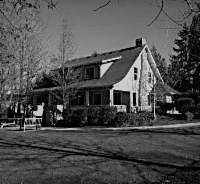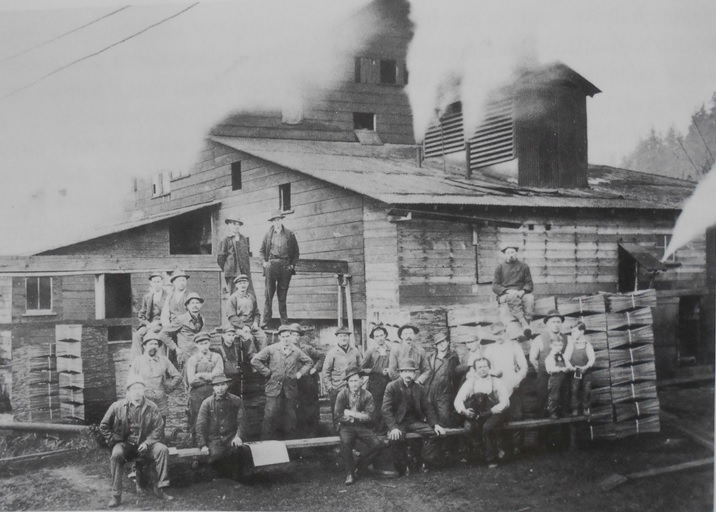Article by Carla Trsek
Eastside Stories is our way of sharing Eastside history through the many events, people places and interesting bits of information that we collect at the Eastside Heritage Center. We hope you enjoy these stories and share them with friends and family.
Kelsey Creek Farm is a very popular city park in Bellevue, but its agricultural story goes back several decades before Bellevue incorporated. The land was first farmed by the Duey family in the 1920s and 1930s. William Duey worked on a farm in Skagit Valley, but when he heard about land available for rent in what is now Bellevue, he moved with his wife and three children in 1921 to start their own dairy.
The land belonged to the Haller family, a Seattle family with extensive Eastside land holdings. In addition to the land that became Kelsey Creek Farm, the wealthy family also owned the land that became the Glendale Golf Course along the park’s northern border.
The Duey’s first barn before the 1933 fire. Note the angled roofs. Photo courtesy City of Bellevue.
It was far from ideal farmland. Most of the property was either covered with stumps or soaked in wetlands. The stumps came from the Hewitt-Lea Lumber Company, which had logged the site around the turn of the century. Additionally, no roads connected the farm to the small town of Bellevue. The only access to the property was a railroad bed with the ties still in place. It had only gone out of service two years before the Duey family moved in.
William and Pearl Duey and their three children, Fernley, Alta, and William Jr., quickly got to work pulling out stumps, building a house, building a barn and establishing a herd of dairy cows. They milked the cows twice a day and delivered milk, cream, and butter to customers once a day. They named their farm Twin Valley Dairy in honor of the two valleys that parallel either side of the barns.
The Duey’s second barn after the 1933 fire. Note the rounded roof. This barn still stands at Kelsey Creek Farm and houses the park’s resident animals. Photo courtesy City of Bellevue.
The Twin Valley Dairy provided a good life for their family but they were not always financially secure. Especially during the 1930s when people who couldn’t pay for their milk in cash, they would offer services or products from their own farms in return. Additionally, the logging operation that preceded the farm and bedeviled the Dueys as they pulled out stump after stump at least provided the family with a second source of income. There was so much downed cedar on the property left over from the logging operation that Mr. Duey cut and sold cedar fence posts.
The heart of the dairy were the cows. The herd was made of a mix of dairy breeds common during the period, including Brown Swiss, Guernsey, and Jersey. They kept about thirty milking cows, but the total bovine population rose and fell with the births and sales of calves. The cows lived year-round in the pastures, although they probably were taken into the barn for milking and possibly for calving. In a small barn just south of the main barn, milk was bottled and cream and butter were made.
In 1933, the barn and 90 tons of hay stored in its hay loft burned to the ground. The Duey’s youngest son Fernley remembered that “the whole hillside was afire. It was a mess. We had to milk the cows and tie them to a fence for several days until another barn could be built.” That new barn was built amazingly quickly. Neighbors and hired hands put up the structure in just a few weeks. The Duey’s continued to provide milk, cream, and butter to Eastside customers through the end of the decade.
William and Pearl Duey in front of their milk truck, c. 1930s. Photo courtesy City of Bellevue.
At the beginning of World War II, the Duey family moved off the property and the Haller family sold it to a man named John Michael. The Duey family sold him their business, including their cows. Michael expanded the dairy herd and built a larger barn to the north of the Duey’s barn with material purchased from Dunn Lumber in Seattle.
All three barns are protected as part of the city’s park. The small milk barn is now painted red and serves as offices for the site’s staff. The Duey’s big barn is now painted white and houses the park’s resident farm animals and Michael’s larger white barn serves as classrooms and offices. In a city now dominated by growing business interests, Kelsey Creek Farm provides a tangible connection to Bellevue’s agricultural history.
References:
Harvey, David W. “Historical Analysis of Kelsey Creek Community Park Barns Bellevue, Washington.” For Kovalenko Architects and City of Bellevue Parks and Recreation Department. October 1991.
Jones and Jones. “Kelsey Creek Community Park Renovation Plan.” City of Bellevue Department of Parks and Recreation. June 1993.
McDonald, Lucile. “Kelsey Creek Park land still being farmed.” Journal American. April 23, 1979.
Our Mission To steward Eastside history by actively collecting, preserving, and interpreting documents and artifacts, and by promoting public involvement in and appreciation of this heritage through educational programming and community outreach.
Our Vision To be the leading organization that enhances community identity through the preservation and stewardship of the Eastside’s history.













